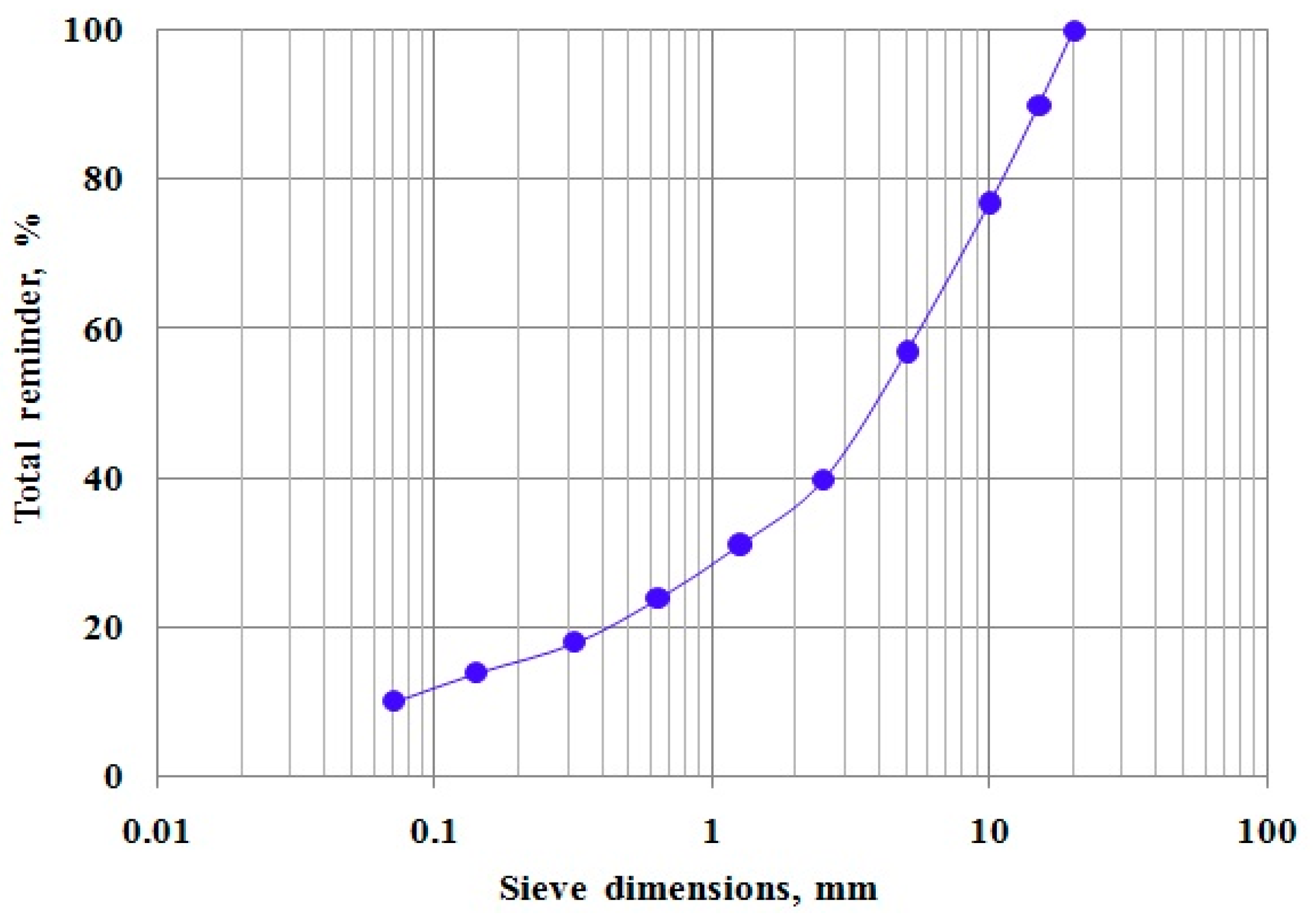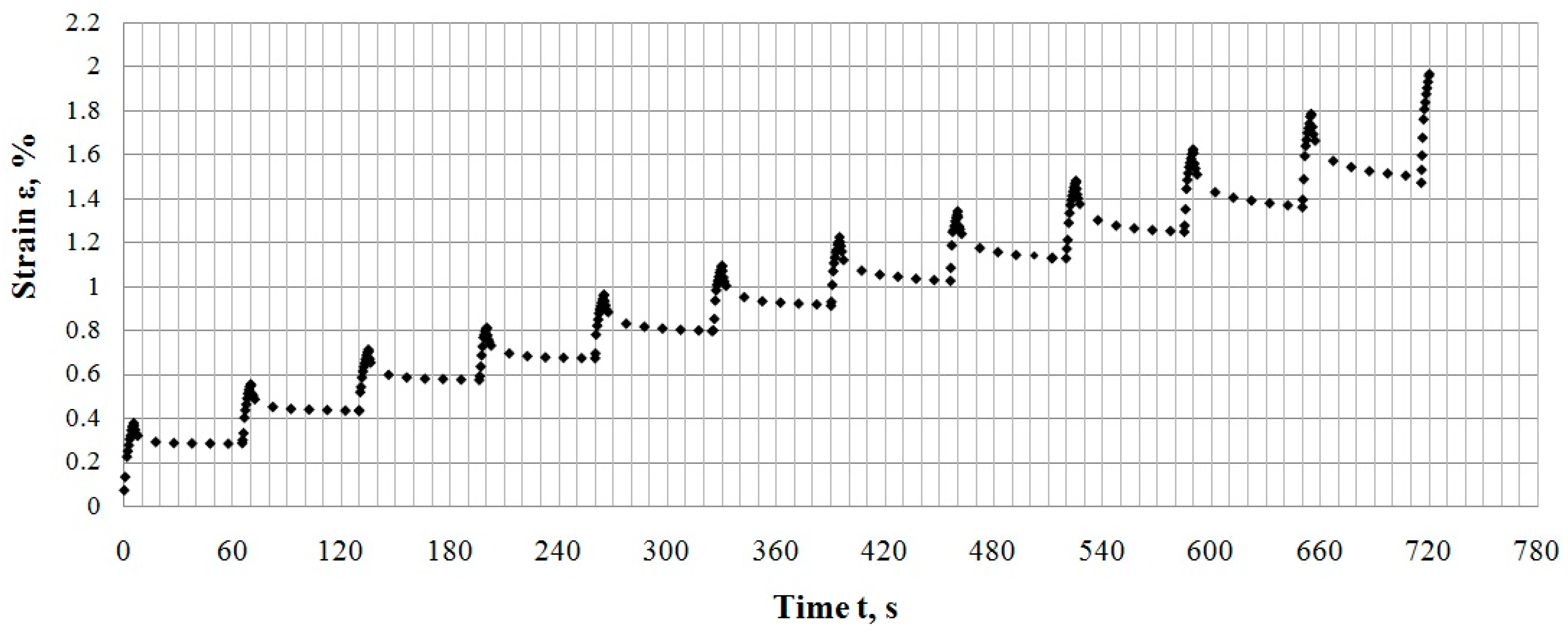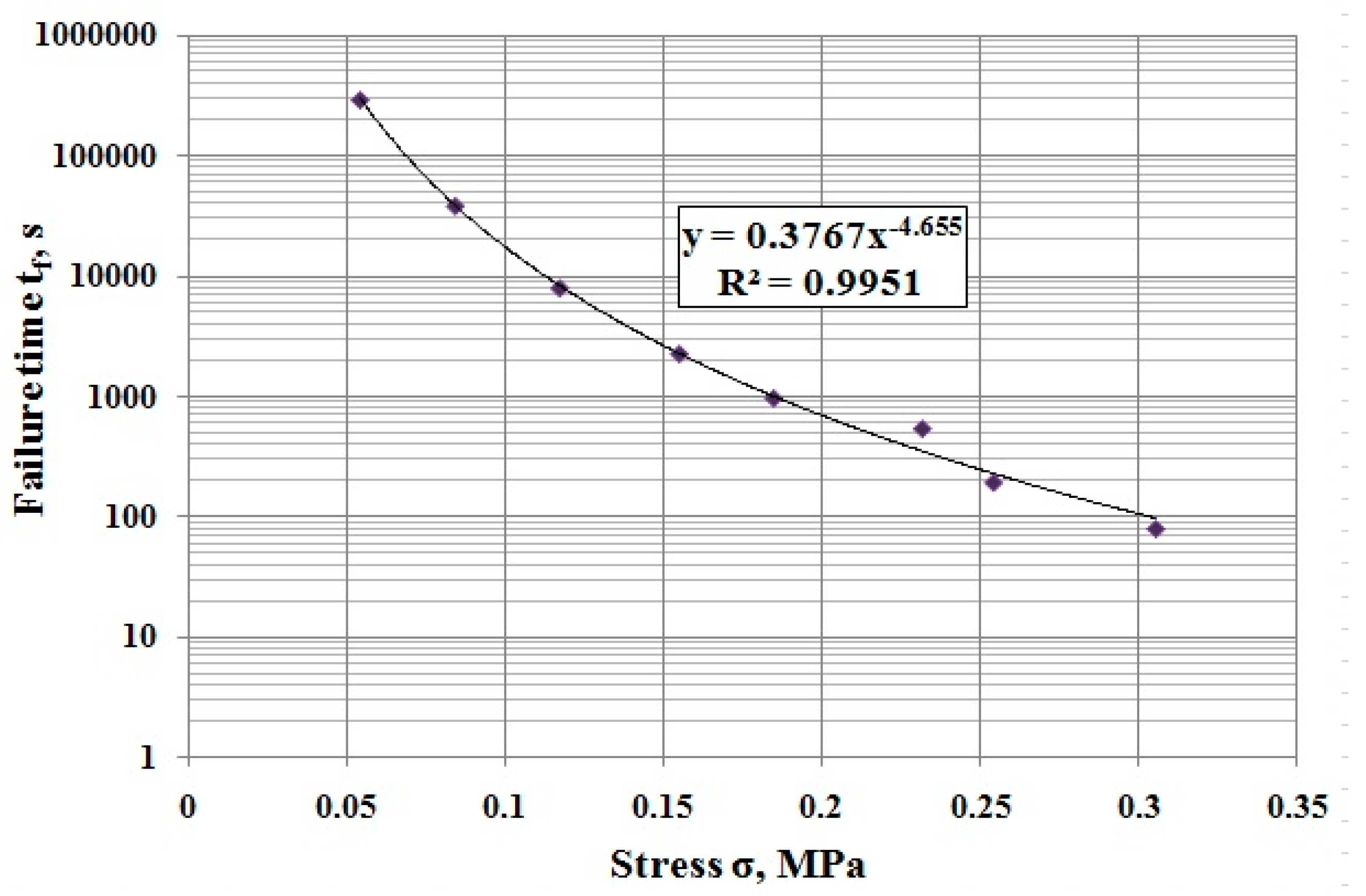1. Introduction
Asphalt concrete layers of highways during their service life are subject to complex combinations of mechanical impacts of vehicles’ wheels and environmental temperature. As is known, the mechanical properties of asphalt concrete depend greatly on temperature and load characteristics, such as value, duration, and rate of loading [
1,
2,
3]. Therefore, the experimental determination of asphalt concrete characteristics, as well as modeling of its mechanical behavior in conditions close to the real ones, is practically important.
The mechanical failure of asphalt concrete pavement of the highway occurs gradually under impact of frequently repeated vehicle’s load, i.e., the damage occurring with each passage of the vehicle’s wheel is accumulated.
There are several approaches to taking into account the damage accumulation in asphalt concrete pavements. For example, the four-point bending test is used [
4,
5].
The vehicles running along the highways have different numbers of axles, the load on which varies within the wide range. It is natural that the axles with different values of load cause different damage levels for pavement. One of the prediction models for materials and structures damage, considering load impact of different values, is the well-known Miner’s law [
6]. Miner’s law is also known as the principle of linear summation of damages [
7] and has found wide application in engineering calculations. For example, in the US, it is used for prediction of the fatigue life for the asphalt concrete pavement of highways [
8]. In this regard fatigue damage is calculated under the following equation:
where
D is damage,
T is total number of periods,
is actual traffic period
i, and
is traffic allowed under conditions prevailing in
i.
Vehicles run along the highway with different speed, i.e., they affect the pavement structure for a different duration. As under real road conditions, the speed of the vehicles varies within wide ranges, and axle load duration differs greatly. Unfortunately, Equation (1), based on Miner’s law, does not consider load duration, which can be a source of systematic large inaccuracies during determination of fatigue life for asphalt concrete pavement of the highway.
At present, the so-called Bailey’s criterion is well known in science and engineering practice [
9], which can be described in the following form:
where
tp is failure time,
σ(
t) is stress, varied in time, and
τ[
σ(
t)] is dependence of material failure time on stress.
Contrary to Miner′s law (1), Bailey’s criterion (2) considers load duration, i.e., the speed of the vehicle along the highway. Dependence
τ[
σ(
t)] of Bailey’s criterion represents by itself the analytical equation for the so-called curve of long-term strength, which is constructed based on the test results of the material according to the creep scheme [
10,
11,
12].
Regarding asphalt concrete, specialists know well the so-called viscoelastic continuum damage mechanics approach (VECD), which is based on the extended elastic-viscoelastic correspondence principle proposed by R.A. Schapery [
13]. This approach, used for the first time by Little D.N. and Kim Y.R. [
14,
15,
16,
17], has been applied by other researchers for the characterization of asphalt concrete fatigue considering non-linear strain and healing [
18,
19]. In the VECD approach, the physical strain and physical stiffness of the viscoelastic material (asphalt concrete) are replaced for their pseudo similarities, i.e., for pseudo strain and pseudo stiffness, respectively, which are varied from one loading cycle to another. Calculation of pseudo strain requires knowledge of dynamic modulus and phase angle, which can be determined experimentally by appropriate devices.
In this paper, the expression is obtained for determination of cyclic tensile strength for the asphalt concrete, which considers damage accumulation and history of loading, using the long-term strength curve for asphalt concrete, obtained according to the test results of more than 110 samples to failure at stresses from 0.05 to 0.31 MPa, and by introduction of damage kernel.
2. Materials
In this paper, bitumen of grade 100–130 has been used, meeting the requirements of the Kazakhstan standard ST RK 1373-2013 [
20].The bitumen grade on Superpave is PG 64-40 [
21]. Bitumen has been produced by Pavlodar processing plant from crude oil of Western Siberia (Russia) by the direct oxidation method.
Hot dense asphalt concrete of type B, meeting the requirements of the Kazakhstan standard ST RK 1225-2013 [
22], was prepared using aggregate (quartz) fractions of 5–10 mm (20%), 10–15 mm (13%), 15–20 mm (10%) from Novo-Alekseevsk rock pit (Almaty region), sand of fraction 0–5 mm (50%) from the plant “Asphaltconcrete-1” (Almaty city), and activated mineral powder (7%) from Kordai rock pit (Zhambyl region).
Granulometric curve of mineral part of the asphalt concrete is shown in
Figure 1.
Bitumen content of grade 100–130 in the asphalt concrete is 4.8% by weight of dry mineral material.
Samples of the hot asphalt concrete are prepared in form of a rectangular prism with length of 150 mm, width of 50 mm and height of 50 mm in two step procedures. The first step, the asphalt concrete samples were prepared in form of a square slab by means of the Cooper compactor (Cooper Research Technology Ltd., Ripley, UK, model CRT-RC2S) according to the standard EN 12697-33 [
23]. The second step, the samples were cut from the asphalt concrete slabs in form of a prism. Deviations in sizes of the samples did not exceed 2 mm.
Tension load was applied to the sample of the asphalt concrete by means of two metal plates, which were glued to the end surfaces of the sample. The glue was prepared on the basis of epoxide resin. After gluing the metal plates, the samples of the asphalt concrete were kept at the room temperature not less than 24 h on the special device, providing close contact of plates to the ends of the sample.
The detailed information about standard characteristics of bitumen and asphalt concrete can be found in the authors’ previously published paper [
24].
3. Experiment
Tests of hot asphalt concrete samples in the form of a rectangular prism on cyclic creep were carried out according to the direct tensile scheme until complete failure. The 0.31 MPa stress was applied to the tested sample quickly and kept constant for 5 s. Then the stress was removed quickly, and the sample was free of stress for the following 60 s. The test temperature was equal to 22 °C. The tests were carried out in a special assembled installation, which allows applying a load to the asphalt concrete sample within 1 s. The sample strain was measured by means of two clock typed indicators, while data was recorded by a video camera. More detailed information about the device can be also found in the authors’ paper [
24].
Figure 2 and
Figure 3 show the graphs of cyclic strain for two asphalt concrete samples. The first of them resisted 11 full cycles “load-rest,” and the second one only resisted six.
Overall 5 samples of asphalt concrete have been tested, which resisted 6, 12, 10, 11, and 6 full cycles “load-rest,” respectively, to failure. The average number of cycles to failure of asphalt concrete samples is equal to 9.
4. Cyclic Strength Model
4.1. Long-Term Strength
Long-term strength is determined by the time in which the material fails under the impact of the load, suddenly applied and kept constantly [
10,
11,
12]. It is determined based on the test results for the material under the scheme of creep.
Figure 4 shows the graph of long-term strength for fine-grained hot asphalt concrete at the temperature of 22 °С, used in Kazakhstan as the material for pavement of the highways, and
Figure 5 shows the dependence of failure strain for the asphalt concrete on stress.
As it is seen from
Figure 5, the failure strain is small at the testing temperature: maximum strain is 3% at 0.12 MPa. Therefore, the stress in the tested sample of asphalt concrete is calculated under the following formula:
where
F is load and
S is the cross-sectional area of the sample before deformation.
It is seen from
Figure 4 that the long-term strength of the asphalt concrete is approximated satisfactorily by power function. Therefore, approximation function we can adopt in the following form [
10]:
where
is failure time, s,
is stress, MPa,
A is constant, having unit MPa
−n c
−1, and
n is dimensionless exponent.
4.2. Cyclic Loading
The points of pavement structures are under cyclic loadings when the vehicle is passing. One can adopt sequential cyclic loading approximately, as is shown in
Figure 6, during which each cycle consists of two periods. During the first period (
t0), the applied stress
σ remains constant (loading period), and during the second one (
P-t0), the stress does not occur, i.e.,
σ = 0 (relax period). One full loading cycle has the duration
P. In this work, the durations of cycles
P (65 s), loading period
t0 (5 s), and relax period
P-t0 (60 s) are adopted as constant.
4.3. Bailey’s Principle of Damage Summation
Considering the expression (4) Bailey’s principle of damage summation (2) may be written as
In case of cyclic loading,
where
is failure time of material (asphalt concrete) during cyclic loading;
N is number of cycles “load-relax” to failure.
Having replaced
tp for
, and for the case when
σ = const from expression (5) we can have
From expression (7) we can determine
Comparing expression (8) with expression (4), we can find that
In case of P = t0, i.e., when between loading periods there is no relax, then = tp occurs, i.e., time till failure is equal to long-term strength. When there is a relax period between loading periods, as could be expected, P > t0, therefore > tp. It is logically correct. Relax between loadings should increase time to failure.
A serious drawback of the obtained expressions (8) and (9) is that they do not consider the history of loading, i.e., the duration of each loading cycle and their sequence.
4.4. Consideration of Loading History
Further we will use the approach when the process of damage accumulation with creep is evaluated by scalar failure parameter
ω(
t) for the development of the cyclic strength model for the asphalt concrete. The failure parameter
ω(
t) was introduced by Y. N. Rabotnov [
8], and it characterizes the damage level of the material. It increases from 0 to 1 during transition of the material from the initial state to the failure state, i.e.,
According to [
25], we adopt that the process of damage accumulation in the material is of hereditary nature and therefore it can be described by integral equation of the following form:
where
is the damage kernel of the material;
is the instantaneous strength limit.
We will rewrite the Equation (11) in the following form:
where the additive
is the instantaneous damage at the time moment
t = 0.
If to adopt that
ω0 = 0, then we have
Considering that
ω(
tp) = 1 at failure, we will determine from Equation (14) that
The obtained expression (15) is the criterion for material failure under load impact, which varies in time on a random basis.
For the case of creep, i.e., at
σ = const the Equation (15) will be of the following form:
Contrary to expression (8), determined by Bailey’s integral, the Equation (16) considers the hereditary nature of damage accumulation through the kernel .
According to the test results of the material under creep scheme to failure we will have the curve of long-term strength (dependence of failure time on stress and, on the contrary, dependence of stress on failure time), which can be represented in the form of
or in the form of
Therefore, we will rewrite the expression (16) in the form of
The obtained expression (19) represents the equation of the long-term strength curve of the material.
Differentiating the Equation (19), we have
Expression (20) provides an opportunity for determination of the damage kernel П(t) by the curve of the long-term strength for the material σ = σ(tp).
Having substituted the function, chosen earlier (4), approximating curve of the long-term for the asphalt concrete, into the left part of the expression (20), we will have
Comparing expression (21) with expression (20), we will find that
Expression (22) is the equation of the damage kernel for the asphalt concrete, for which the curve of the long-term strength is described by power function of the form (4).
Now having substituted expression (22) into the integral Equation (15), we will have
Therefore, we obtained the failure condition of the asphalt concrete, which considers then history of loading, in the form of integral equation of the hereditary type.
4.5. Strength at Cyclic Loading
We will rewrite Equation (23) in the following form:
where
Having performed the differentiating of the integral Equation (24) in parts, we will have
The failure condition of the asphalt concrete (24) was represented in the form of the Riemann integral. Now, it has been written in the form of Stieltjes integral (26).
In accordance with the scheme of cyclic loading (
Figure 6), we will introduce the following notation:
where
k is the cycle number;
is the beginning of cycle
k.
The stress at the time moment
t in cycle
k we present by the expression
where
is Heaviside unit function
Having substituted the expression (28) into Equation (26), we will have
When obtaining expression (30), it was considered that
where
δ(
t) is delta-function of Dirac, and it has the following property:
Considering expression (6), we will have from expression (30):
Considering expression (4), we will represent expression (30) in the following final form:
The obtained expression (34) provides an opportunity for determination of the loading cycle number to failure of the asphalt concrete at tension. It considers the duration of relax period between loading cycles and the history of loading. The analysis of expression (34) shows that the cyclic strength of the asphalt concrete depends on stress (σ), parameters of long-term strength (A, n), frequency of loading , duration of loading period t0 and relax period P-t0, and ratio of loading period to the long-term strength . In this case, the parameter n is a key characteristics, which shows for what order the long-term strength of the asphalt concrete tp decreases (increases) with the increase (decrease) of the stress σ for one order.
4.6. Experimental Confirmation
The unknown values for the parameters of the long-term strength curve
A and
n have been determined by regression equation in
Figure 4 and approximation function (4).
Number of cycles “load-relax” (stress σ = 0.31 Mpa, loading period duration t0 = 5 c, relax period duration P-t0 = 60 s) to asphalt concrete failure, calculated under expression (34), is equal to 10. Accuracy for calculation is equal to 1.04%. As was mentioned above, the average number of cycles to asphalt concrete sample failure, determined experimentally, is equal to 9.
Therefore, one can believe that expression (34), considering the damage accumulation and the history of loading, describes satisfactorily the cyclic tensile strength of the asphalt concrete.
In real road conditions, the value of the load and the duration of loading and relax periods can vary within sufficiently extensive range. As was mentioned above, the proposed model (expression (34)) considers these factors. It should be expected that the fatigue strength of the asphalt concrete pavement decreases with the increase of value for load and duration of loading period, and the increase of the relax period between sequential loads increases the fatigue strength.
4.7. Prediction of Fatigue Strength
In real road conditions, the points of the asphalt concrete pavement of the highway are subject to repeated (dozens–hundreds million) cyclic loading of vehicles’ wheels during its service life. Further we will try to predict the fatigue (multi-cyclic) strength of the asphalt concrete pavement, using expression (34), with the following conditions of loading: stress σ = 0.31 MPa, loading period duration t0 = 0.1 s, and relax period duration 9.9 s. The results of the calculation show that the number of cycles to asphalt concrete failure was 86.6 million. The accuracy of calculation is equal to 6.04%.
In real road conditions, the value of the load, duration of loading and relax periods can vary within sufficiently extensive range. As was mentioned above, the proposed model (expression (34)) considers these factors. It should be expected that the fatigue strength of the asphalt concrete pavement decreases with the increase of value for load and duration of loading period, and the increase of the relax period between sequential loads increases the fatigue strength.
Having determined the long-term strength for the asphalt concretes experimentally (
Figure 4 or expression (4)) at various temperatures, we will obtain the opportunity for prediction of the fatigue strength for the asphalt concrete pavements by means of the proposed model considering real traffic.
The parameters A and n in the proposed model for cyclic strength of asphalt concrete may be different from the lab-produced specimens to mixes manufactured in a plant and laid and compacted in site in dependence on thickness of asphalt concrete layers and climatic conditions. Therefore, the recommended values of the parameters should be finally defined through site calibration.











